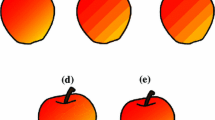Abstract
Vector graphic gives us a new solution to the representation of raster images. Among many types of vectorized representations, the most popular is mesh representation, which inherits the benefits of vector graphics. Inspired by mesh, we propose a novel patch-based representation for raster images, in which pixels are partitioned into regions, and pixels belonging to the same region are converted into a 3D point cloud and approximated by a 3D planar patch with proper boundaries in a variational way. The resulting patches are then encoded via a half-edge structure for storage. The key point is that the vertices of boundaries are not located on the very positions of sample points, i.e. converted pixels, but dependent on the optimal position of the patch, which theoretically reduces the fitting errors. Experiments show that our algorithm produces better results.
创新点
1、提出了一种基于块的图像矢量化表达方式,改进了传统对网格顶点颜色值的确定方法,由原来的直接利用所在像素点的颜色值改为由最终的优化结果决定,使得重建效果较之前的方法有所提高;2、算法采用类半边结构编码并存储平面块集合的拓扑信息,使得图像表达简洁高效。
Similar content being viewed by others
References
Cohen-Steiner D, Alliez P, Desbrun M. Variational shape approximation. ACM Trans Graphics, 2004, 23: 905–914
Adams M D. A flexible content-adaptive mesh-generation strategy for image representation. IEEE Trans Image Process, 2011, 20: 2414–2427
Demaret L, Dyn N, Iske A. Image compression by linear splines over adaptive triangulations. Signal Process, 2006, 86: 1604–1616
Demaret L, Iske A, Mathematik Z, et al. Advances in digital image compression by adaptive thinning. Ann MCFA, 2004, 3: 105–109
Li P, Adams M D. A tuned mesh-generation strategy for image representation based on data-dependent triangulation. IEEE Trans Image Process, 2013, 22: 2004–2018
Yang Y Y, Wernick M N, Brankov J G. A fast approach for accurate content-adaptive mesh generation. IEEE Trans Image Process, 2003, 12: 866–881
Xia T, Liao B B, Yu Y Z. Patch-based image vectorization with automatic curvilinear feature alignment. ACM Trans Graphics, 2009, 28: 115
Lai Y-K, Hu S-M, Martin R R. Automatic and topology-preserving gradient mesh generation for image vectorization. ACM Trans Graphics, 2009, 28: 85
Sun J, Liang L, Wen F, et al. Image vectorization using optimized gradient meshes. ACM Trans Graphics, 2007, 26: 11
Jeschke S, Cline D, Wonka P. Estimating color and texture parameters for vector graphics. Comput Graphics Forum, 2011, 30: 523–532
Orzan A, Bousseau A, Barla P, et al. Diffusion curves: a vector representation for smooth-shaded images. Commun ACM, 2013, 56: 101–108
Orzan A, Bousseau A, Winnemoeller H, et al. Diffusion curves: a vector representation for smooth-shaded images. ACM Trans Graphics, 2008, 27: 101–108
Nagai Y, Ohtake Y, Yokota H, et al. Boundary-representable partition of unity for image magnification. Sci China Inf Sci, 2013, 56: 112106
Wang M, Lai Y-K, Liang Y, et al. BiggerPicture: data-driven image extrapolation using graph matching. ACM Trans Graphics, 2014, 33: 173
Hu S-M, Zhang F-L, Wang M, et al. PatchNet: a patch-based image representation for interactive library-driven image editing. ACM Trans Graphics, 2013, 32: 196
Li H, Wu W, Wu E H. Robust interactive image segmentation via graph-based manifold ranking. Comput Visual Media, 2015, 1: 183–195
Chen X W, Zhou B, Guo Y, et al. Structure guided texture inpainting through multi-scale patches and global optimization for image completion. Sci China Inf Sci, 2014, 57: 012102
Lai Y-K, Martin R R. Vertex location optimisation for improved remeshing. Graphical Models, 2012, 74: 233–243
Douglas D H, Peucker T K. Algorithms for the reduction of the number of points required to represent a digitized line or its caricature. Int J Geogr Inf Geovisualization, 1973, 10: 112–122
Zhang M, Yan W, Yuan C M, et al. Curve fitting and optimal interpolation on CNC machines based on quadratic B-splines. Sci China Inf Sci, 2011, 54: 1407–1418
Huynh-Thu Q, Ghanbari M. Scope of validity of PSNR in image/video quality assessment. Electron Lett, 2008, 44: 800–835
Wang Z, Bovik A C, Sheikh H R, et al. Image quality assessment: from error visibility to structural similarity. IEEE Trans Image Process, 2004, 13: 600–612
Sieger D, Botsch M. Design, implementation, and evaluation of the surface mesh data structure. In: Proceedings of the 20th International Meshing Roundtable, Paris, 2012. 533–550
Author information
Authors and Affiliations
Corresponding author
Rights and permissions
About this article
Cite this article
Xie, H., Tong, R. Patch-based variational image approximation. Sci. China Inf. Sci. 60, 032104 (2017). https://doi.org/10.1007/s11432-016-0130-4
Received:
Accepted:
Published:
DOI: https://doi.org/10.1007/s11432-016-0130-4




